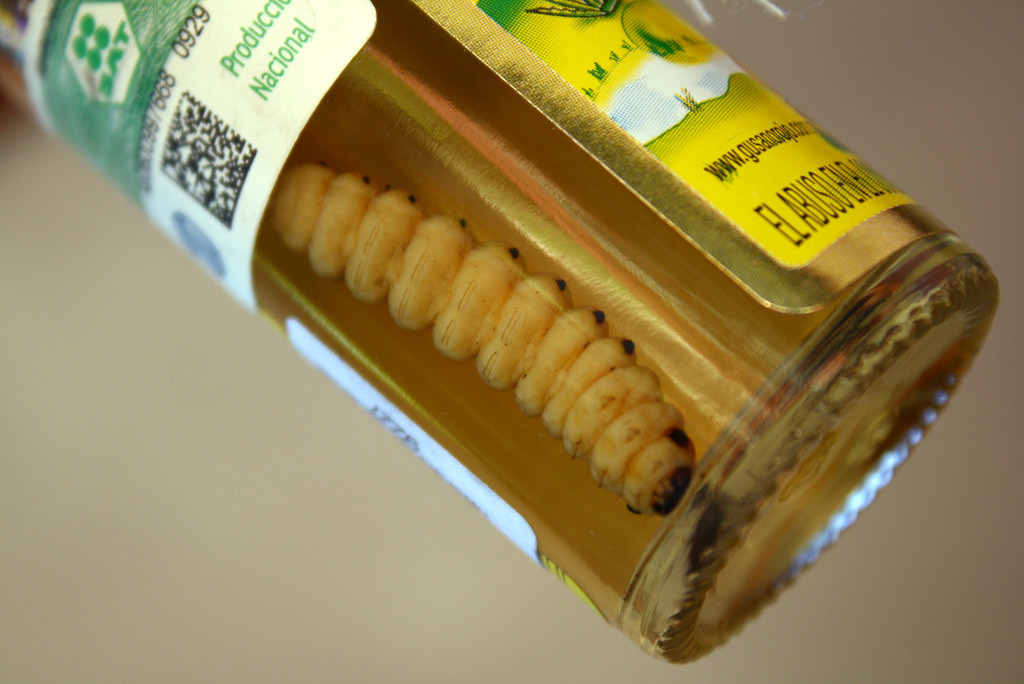Many people who drink tequila have long held the false belief that some of it is sold with a worm in its bottle. Since the manufacture and export of tequila are subject to stringent laws in Mexico, this statement is always false.
Mezcal with Gusano refers to Mezcal that has traditionally been sold with the “worm” still present in the bottle. Despite both being distilled from the agave plant and produced in Mexico, mezcal and tequila are completely different spirits. To address the question “What tequila has a worm in it?” we have investigated the origins of the myth of the “tequila worm.” I’ve compared and contrasted these two well-known Mexican alcoholic beverages and detailed their respective histories.
The Urban Legend of the Tequila Worm
There’s been talk for years that some brands of tequila have a worm in the bottle. Some even claim that eating the worm would cause you to have a psychedelic experience due to its hallucinogenic characteristics.
Neither myth is grounded in reality, as no insect-infused tequilas are currently commercially available. In Jalisco, Mexico, where tequila is traditionally made, regulations forbid the use of any worms or other unusual ingredients. There are still a few brands producing mezcal in the traditional method, which involves placing worms in each bottle. There are no hallucinatory effects from consuming the worm, yet worms were once a regular ingredient in mezcal.
Traditional Additions to Tequila and Mezcal
Before looking into worms in bottles of tequila and mezcal, it’s pertinent to highlight that the practice of adding insects or other elements to these beverages isn’t completely unheard of in historical contexts. However, when it comes to tequila, the regulations are stringent, and no additions of insects or animals are permitted. Meanwhile, mezcal has a more lenient approach.
Historical Inclusions in Mezcal
- Scorpions: In some instances, mezcal producers have used scorpions instead of worms. These are often used in mezcal to emphasize its bold and wild characteristics, similar to the gusano worm, adding an exotic touch to the spirit. Though it is less common, you can still find mezcal with scorpions, mainly used for marketing purposes.
- Fruits and Nuts: While not insects or animals, it’s worth noting that some mezcals are infused with local fruits, nuts, and other botanicals to enhance the flavor profile of the mezcal.
Products on the Market Today
- Mezcal with Scorpion: While not abundantly available, there are a few brands that offer mezcal with a scorpion in the bottle, playing on the traditional, albeit not mainstream, practice of including creatures in the spirit to denote its wild and robust nature.
Gusano-Infused Mezcal
Mezcal with Gusano, which translates to “mezcal with worm” in English, is the name given to the variety of mezcal that includes the infamous worm. Once a staple of mezcal shipments to the US market, presently this kind of spirit makes up less than 10% of the total supply.
Every bottle of Mezcal with Gusano comes with a “worm” that is better accurately described as a grub. The grub is the larva of a Mexican moth that eats on the agave leaves used to make Mezcal with Gusano in their natural habitat. Insects like these are considered a delicacy in some parts of Mexico and are commonly cooked and eaten by locals. These larvae are now typically exclusively found in cheap bottles of mezcal that exploit the worm marketing strategy.
What Do the Experts Have to Say About These Additions in Mezcal and Tequila?

We reached out to a panel of experts in the spirits and tequila industry. The goal was to understand their perspective on these traditions and to gauge if such practices have a place in the future of the industry.
Carlos Ramirez, a renowned mezcal producer, stated, “The practice of including guano worms and even scorpions at times does stem from a deep-rooted tradition, showcasing the wild and rustic nature of mezcal. It creates a sense of authenticity and connection to the history and land from which mezcal originates.” He did acknowledge that these traditions are less common now, and such bottles form a small niche in today’s market.
Meanwhile, Ana Gonzalez, a spirit analyst and author, expressed her skepticism about the necessity of continuing this practice. “Given the stringent regulations around tequila production, the practice never caught on in the tequila industry, rightly so, in my opinion. It feels more like a marketing gimmick now, and the modern consumer is more informed and prefers purity and quality over such novelties,” she argued.
A master sommelier with years of experience, David Lee noted, “The gusano worm does have its place in the history of mezcal, but moving forward, it seems the industry is heading towards a more refined and sophisticated direction, emphasizing quality and the unique flavors each agave plant can offer rather than relying on the ‘shock value’ of having a worm or scorpion in the bottle.”
Julio Mendez, a third-generation mezcal producer, had a slightly different take, suggesting a potential revival in the tradition as part of the craft spirit boom. “I believe there is still a market for traditional mezcal with gusano, especially among those looking to experience the spirit in its most authentic form, drawing on its deep historical roots,” Mendez expressed, hinting at a possible resurgence powered by the consumers’ desire for authenticity.
So we have all of this opinion, what do you think? To help you er on the side of caution, we have a few answered questions you may be dying to ask as well as a further breakdown of the difference between Mezcal and Tequila, do you know?
Mezcal VS. Tequila
Mezcal is a type of distilled liquor made from a wide range of agave plants. Any region in Mexico or anywhere that grows agave can produce mezcal from any of the many diverse agave species.
The manufacture and origin of tequila are much more restricted to the state of Jalisco in Mexico. To make tequila, only the highest quality Blue Weber Agave is required, and there are strict guidelines for how it should be made. Most other mezcals are not as well-known or highly-regarded as tequila, despite tequila’s worldwide popularity and recognition. With the rising popularity of handmade spirits and innovative smokey flavors, the mezcal market is booming.
You Ask And We Answer
When Compared to Tequila, What Is Mezcal?
- Mezcal and tequila, two popular Mexican alcoholic beverages, are commonly confused with one another, but they are quite distinct and have different regulatory requirements.
- Mezcal, on the other hand, can be manufactured with any kind of Agave rather than just the one used to make tequila, which is available only in the state of Jalisco in Mexico.
What Is The Meaning of “Mezcal with Gusano”?
The style of mezcal known as Mezcal with Gusano (roughly, “mezcal with worm”) is largely responsible for spreading awareness of mezcal across the United States during the 1990s. The worm turned out to be a brilliant promotional tool, and mezcal quickly became popular in the United States.
Is It Unsafe to Consume Mezcal Because of the Worm?
The idea of gnawing on a dead worm that was suspended in a bottle of mezcal for a long time may not sound appetising, yet eating the worm poses no known health hazards and is generally regarded harmless. Tequila production guidelines forbid the inclusion of a worm in the bottle, contrary to the widespread belief that some varieties of the spirit do. However, there are distinct types of mezcal that incorporate this well-known insect, even though its consumption has no hallucinogenic effects, contrary to popular belief and urban mythology.

